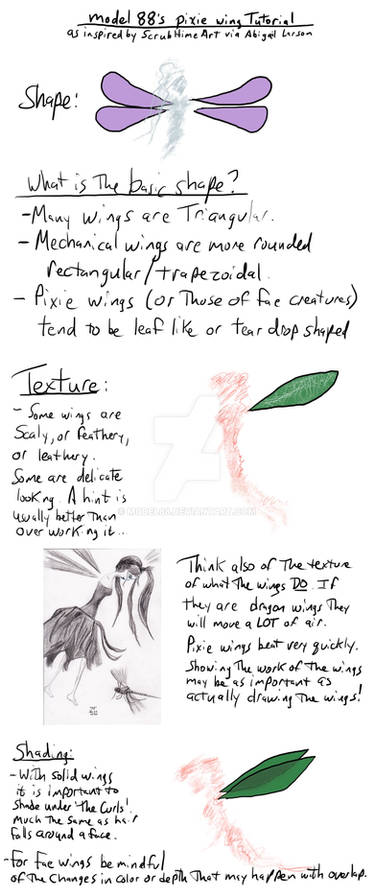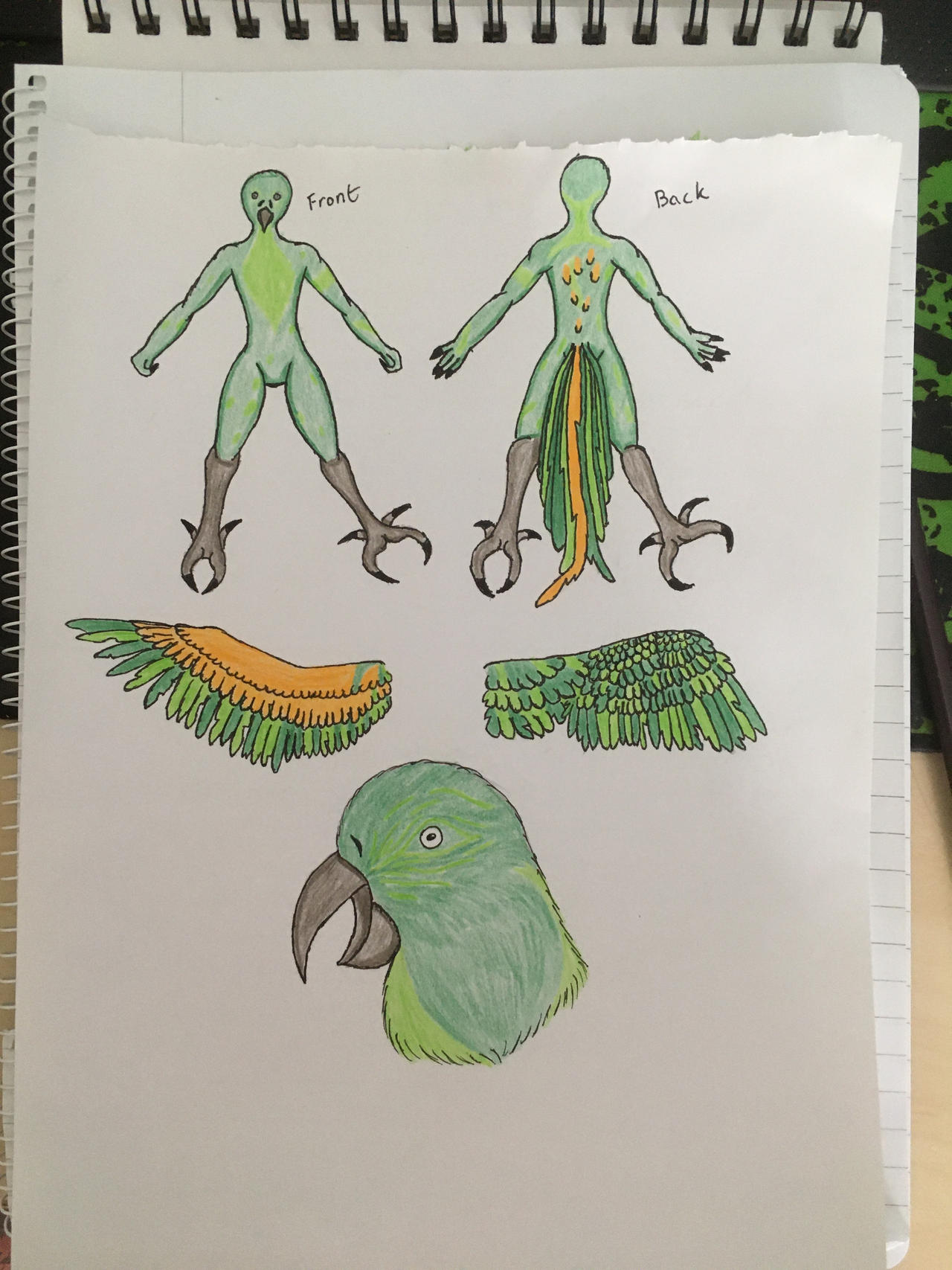ShopDreamUp AI ArtDreamUp
Deviation Actions
Suggested Deviants
Suggested Collections
You Might Like…
Featured in Groups
Badge Awards
Description
Please read before using this tutorial:
1. This is a very basic wing drawing tutorial and is aimed at beginners and those unfamiliar with wing anatomy. It is NOT supposed to rival a scientific paper for sheer technical accuracy. I tried to keep terms and things simple for the ease of the beginner. I drew it very quickly and it's messy... it's not perfect. I just hoped to help demonstrate some of the main elements of bird wings.
2. This is here to help people until I have time to make a really good tutorial. This is only basic information and does NOT cover all aspects of drawing bird wings. Please rest assured that someday, when I have more time, I will make a more in-depth tutorial that covers far more than this one does.
3. I do not claim to be an expert. I do art for a living, and yes a lot of my art contains bird wings. I have 4 companion parrots. I study wings a lot. But I am not an expert. This tutorial is a tool; use it and continue with your own research and knowledge seeking.
The artist's thoughts on style and accuracy:
Each artist has a style.
Mediocre artists will attempt to use a 'style' to try and cover for the fact that they do not understand anatomy and other art basics.
Good artists will never use 'style' as a crutch or excuse and make an attempt to learn.
The best artists will learn accurate anatomy and learn how to accurately draw and THEN apply their style to it to create something unique. Then an artist truly has a style that they can be proud of.
That said, you can be a great artist and not have perfect anatomy. Learning anatomy is a great tool to improve but do not let it deter you from making art. Art is evolution- perfection is for photographs. You can have the best anatomy ever in your art but unless you do it with feeling it can still be 'soulless'. Have fun with what you do, and as long as you keep trying that is what matters. No one is perfect, and that's a good thing!!
So, about the tutorial itself:
What I am attempting to do here is to help artists that struggle with wings to learn the basics. The best thing you can do for yourself is to draw birds and wings from life. Go to the zoo, or an aviary, or Bush Gardens, or a park with pigeons or ducks, or even in front of Animal Planet and sketch. No tutorial can ever replace seeing and understanding how wings work in motion, on real animals.
Some tips:
-Start with the bones.
-If you can get the anatomy of the bones down, you’ve already gotten past the worst of mistakes
-Like human arm, but hand bones are fused
-One of worst wing mistakes is not enough joints or too many. Easy to remember- look at your arm!
-Wing bones can never be fully straight like a human arm.
-Bird bones are hollow with ‘honeycomb’, making them light and strong.
-Primaries attach to ‘hand’, secondaries to ulna. Follow these two rules and you’re golden.*
-Little to no down on primaries & secondaries
-Primaries can be shaped different. Slotted feathers help at low speed & soaring (hawks, eagles, vultures). Tapered are better at high speed and gliding (falcons, albatross, pigeons). Bunt wings are for woodland birds/short bursts of speed flight (grouse, turkey. sparrow).
-Primaries and some secondary are not split evenly by feather shaft. Primary thicker along leading edge, tapering like airfoil. Effect lessens as you go ‘down’ the wing.
-Scapulars cover much of humerus and into shoulder. They transition wing to body.
-Primaries tend to be thick and require considerable force to bend. Do not ‘flutter’ like hair
-Wings are essentially many flat planes. Draw flat planes in perspective, then flesh out details and subtle curvatures.
-Main groupings- Primaries, secondaries, coverts, scapulars.
-Thickest part of wing is at shoulder/along wing bones.
* - This is a generic wing guide. Some species of birds do have feathers attached to the humerus (mostly sea birds and some waterfowl) but these are the exception rather than the rule. For drawing generic wings for fantasy creatures, the above guide is accurate. If your drawing requires species-accurate wings you should research the feathers on that species.
Finally, please respect copyright. I created and drew this tutorial to try and help people. I didn't really have time to do it but I did anyhow because I am genuinely trying to help. Don't make me regret it by ganking it! Use this as much as you'd like to help you learn, but re-posting this image without permission is forbidden. This is NOT stock. It is a guide.
Additional Resources:
Wing photos from real birds:
[link]
Notes on flight:
[link]
[link]
Also, for some great photos of wings that are a solid color and easy to study, be sure to check out ! She has gorgeous photos. Just be respectful- you should never take or copy photos without permission!!
! She has gorgeous photos. Just be respectful- you should never take or copy photos without permission!!
You may see the rest of my tutorials here:
[link]
1. This is a very basic wing drawing tutorial and is aimed at beginners and those unfamiliar with wing anatomy. It is NOT supposed to rival a scientific paper for sheer technical accuracy. I tried to keep terms and things simple for the ease of the beginner. I drew it very quickly and it's messy... it's not perfect. I just hoped to help demonstrate some of the main elements of bird wings.
2. This is here to help people until I have time to make a really good tutorial. This is only basic information and does NOT cover all aspects of drawing bird wings. Please rest assured that someday, when I have more time, I will make a more in-depth tutorial that covers far more than this one does.
3. I do not claim to be an expert. I do art for a living, and yes a lot of my art contains bird wings. I have 4 companion parrots. I study wings a lot. But I am not an expert. This tutorial is a tool; use it and continue with your own research and knowledge seeking.
The artist's thoughts on style and accuracy:
Each artist has a style.
Mediocre artists will attempt to use a 'style' to try and cover for the fact that they do not understand anatomy and other art basics.
Good artists will never use 'style' as a crutch or excuse and make an attempt to learn.
The best artists will learn accurate anatomy and learn how to accurately draw and THEN apply their style to it to create something unique. Then an artist truly has a style that they can be proud of.
That said, you can be a great artist and not have perfect anatomy. Learning anatomy is a great tool to improve but do not let it deter you from making art. Art is evolution- perfection is for photographs. You can have the best anatomy ever in your art but unless you do it with feeling it can still be 'soulless'. Have fun with what you do, and as long as you keep trying that is what matters. No one is perfect, and that's a good thing!!
So, about the tutorial itself:
What I am attempting to do here is to help artists that struggle with wings to learn the basics. The best thing you can do for yourself is to draw birds and wings from life. Go to the zoo, or an aviary, or Bush Gardens, or a park with pigeons or ducks, or even in front of Animal Planet and sketch. No tutorial can ever replace seeing and understanding how wings work in motion, on real animals.
Some tips:
-Start with the bones.
-If you can get the anatomy of the bones down, you’ve already gotten past the worst of mistakes
-Like human arm, but hand bones are fused
-One of worst wing mistakes is not enough joints or too many. Easy to remember- look at your arm!
-Wing bones can never be fully straight like a human arm.
-Bird bones are hollow with ‘honeycomb’, making them light and strong.
-Primaries attach to ‘hand’, secondaries to ulna. Follow these two rules and you’re golden.*
-Little to no down on primaries & secondaries
-Primaries can be shaped different. Slotted feathers help at low speed & soaring (hawks, eagles, vultures). Tapered are better at high speed and gliding (falcons, albatross, pigeons). Bunt wings are for woodland birds/short bursts of speed flight (grouse, turkey. sparrow).
-Primaries and some secondary are not split evenly by feather shaft. Primary thicker along leading edge, tapering like airfoil. Effect lessens as you go ‘down’ the wing.
-Scapulars cover much of humerus and into shoulder. They transition wing to body.
-Primaries tend to be thick and require considerable force to bend. Do not ‘flutter’ like hair
-Wings are essentially many flat planes. Draw flat planes in perspective, then flesh out details and subtle curvatures.
-Main groupings- Primaries, secondaries, coverts, scapulars.
-Thickest part of wing is at shoulder/along wing bones.
* - This is a generic wing guide. Some species of birds do have feathers attached to the humerus (mostly sea birds and some waterfowl) but these are the exception rather than the rule. For drawing generic wings for fantasy creatures, the above guide is accurate. If your drawing requires species-accurate wings you should research the feathers on that species.
Finally, please respect copyright. I created and drew this tutorial to try and help people. I didn't really have time to do it but I did anyhow because I am genuinely trying to help. Don't make me regret it by ganking it! Use this as much as you'd like to help you learn, but re-posting this image without permission is forbidden. This is NOT stock. It is a guide.
Additional Resources:
Wing photos from real birds:
[link]
Notes on flight:
[link]
[link]
Also, for some great photos of wings that are a solid color and easy to study, be sure to check out
You may see the rest of my tutorials here:
[link]
Image size
600x4000px 322.62 KB
© 2008 - 2024 Nambroth
Comments208
Join the community to add your comment. Already a deviant? Log In
I did my first run at realistic wings today. I used this tutorial as a help, nothing to write home about but here it is:




































